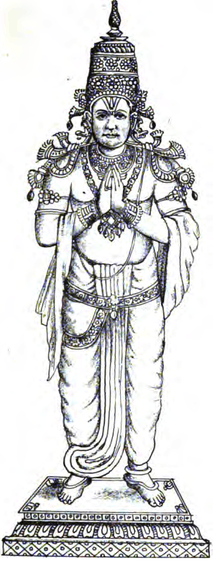Kulashekhara Alwar
| Kulasekhara Alvar | |
|---|---|
 A modern depiction of Kulasekhara Alvar (19th century) | |
| Religion | Hinduism |
| Philosophy | Vaishnava/Bhakti |
| Personal | |
| Born |
Sthanuravi Kulasekhara[1] Makotai/Tiruvancikalam (present day Cranganore), Thrissur |
| Died | Mannarkovil, Tirunelveli |
| Literary works | Mukundamala and Perumal Tirumoli (Tamil) |
Kulasekhara Alvar (born Sthanuravi, royal epithet Kulasekhara), seventh of the twelve Alvars, was the second known ruler of the Cera Perumal kingdom of Cranganore (c. 800—1124 AD ). Modern historians assume that he ruled Kerala between 844 — 883 AD from Makotai, modern Cranganore.[2]
As per native sources, Kulashekhara Alvar was born on the banks of Periyar to certain Drdhavrata.[3][4]He incarnated on the Earth in the 27th year after the beginning of the Kali Yuga (3102 BC), thus 3075 BC.[5][5] In addition to Kerala, Kulashekhara Alvar is described by some sources to have ruled Koli (modern-day Uraiyur), Kudal (modern day Madurai) and Kongu Natu.[6][7][8] He bore titles such as Kolli-Kavalan(guradian of Kolli Hills), Kudal-Nayagan(the Hero of Madurai) and Koli-Kon(the king of Cholas).[9]
Kulasekhara Alvar is considered as the author of Sanskrit lyrics Mukundamala and Perumal Tirumozhi, which are compiled as a part of Nalayira Divya Prabandham. He is sometimes identified as Kulasekhara, the author of the Sanskrit works such as Tapatisamvaranam, Subhadradhananjaya and Vichchinnabhiseka.[10][11] [12][6]
His poems are devotional in nature, being dedicated to the most prominent avataras of Vishnu - Rama and Krishna. A devotee of Rama, he considered the painful experiences of Rama to be his own. He is therefore also known as 'Perumal', meaning 'The Great' – an epithet for god Rama. His devotion was so intense that he worshiped the devotees as forms of Vishnu. In one song, he identifies himself with Devaki, the real mother of Krishna, from whom Krishna was taken away to Gokula where Nanda and Yasoda, the foster parents, looked after them. Kulasekara Alvar expresses Devaki's desolation at being separated from her child and for union with him.[13][14]
Kulashekhara Alvar is thought to have died at Mannarkovil, where there is a temple called Kulasekara Alvar Koyil. The mural inscriptions there informs that the temple was consecrated to his memory by Vasudevan of Mullappalli, Malaimandalam .[15]
The Maharajas of Travancore claims to be the descendants of Kulasekhara Alvar. One of the titles the Maharajas had was Kulasekhara Perumal.
Notes
- ↑ Narayanan, M. G. S. "Perumals of Kerala: Brahmin Oligarchy and Ritual Monarchy—Political and Social Conditions of Kerala Under the Cera Perumals of Makotai (c. AD 800–AD 1124)" in Kongu Vellalar (Gounder) Community in Kerala. Calicut University Press. 1996
- ↑ Narayanan, M. G. S. "Perumals of Kerala: Brahmin Oligarchy and Ritual Monarchy—Political and Social Conditions of Kerala Under the Cera Perumals of Makotai (c. AD 800–AD 1124)" Kerala. Calicut University Press. 1996
- ↑ "A History of Indian Literature, 500-1399: From Courtly to the Popular", p. 29, by Sisir Kumar Das
- ↑ History of Classical Sanskrit Literature, p. 277, by M. Srinivasachariar
- 1 2 M. Srinivasachariar (1974). History of Classical Sanskrit Literature: Being an Elaborate Account of All Branches of Classical Sanskrit Literature, with Full Epigraphical and Archaeological Notes and References, an Introduction Dealing with Language, Philology, and Chronology, and Index of Authors & Works. Motilal Banarsidass Publishe. pp. 278–. ISBN 978-81-208-0284-1.
- 1 2 Dalal 2011, p. 214
- ↑ "Mukundamālā", p. 16, by K. P. A. Menon
- ↑ "A History of Ancient and Early Medieval India: From the Stone Age to the 12th Century", by Upinder Singh, p. 55, ISBN 9788131716779
- ↑ The Indian Historical Quarterly, Volume 7, Issues 3-4. Ramanand Vidya Bhawan, 1985 - India. p. 645.
- ↑ Menon, Sreedhara A. (1967). A Survey of Kerala History. D. C. Books Kottayam.
- ↑ Lochtefeld, James (2002). The Illustrated Encyclopedia of Hinduism: A-M. The Rosen Publishing Group. p. 337. ISBN 9780823931798.
- ↑ Ishwarananda, Swami (2013). Mukunda Mala. Mumbai, India: Chinmaya Publications. p. 2. ISBN 9788175975699.
- ↑ V. K., Subramanian (2007). 101 Mystics of India. New Delhi: Abhinav Publications. ISBN 81-7017-471-6.
- ↑ Varadpande, Manohar Laxman (1982). Krishna Theatre In India. Abhinav Publications. p. 87. ISBN 9788170171515.
- ↑ The contribution of Kerala to Sanskrit Literature; K. Kunjunni Raja; University of Madras 1980; page 2
References
- Ramanujan, Attipat Krishnaswami (2005). Hymns for the Drowning: Poems for Vishnu. Penguin Books. ISBN 9780144000104.
- Dictionary of Hindu Lore and Legend ( ISBN 0-500-51088-1) by Anna Dallapiccola
- Naalaayira divya prabhandham: Commentary by Dr. Jagadrakshakan (1997). Aazhvaargal Research Centre, Chennai 600017.
- Sri Srirama Bharathi Araiyar 'Sacred Book'. 1995: Dhivya Prabhanda Pathasala, Jalladam Pattai - Chennai, India 601 302.
- A. Srinivasa Raghavan, Nammalvar, (in "Makers of Indian Literature" Series), Sahitya Akademi, New Delhi, India, 1975/1998.
- Sujatha, (Tamil), (in Alvargal - Oor Eliya Arimugam), Visa Publications, Chennai, India, 2007.
- B. S., Chandrababu; S., Ganeshram; C., Bhavani (2011). History of People and Their Environs. Bharathi Puthakalayam. ISBN 9789380325910.
- Chari, S. M. Srinivasa (1997). Philosophy and Theistic Mysticism of the Āl̲vārs. Motilal Banarsidass Publishers. ISBN 9788120813427.
- Dalal, Roshen (2011). Hinduism: An Alphabetical Guide. Penguin Books India. ISBN 9780143414216.
- Das, Sisir Kumar; Sāhitya Akādemī (2005). A history of Indian literature, 500-1399: from courtly to the popular. chennai: Sāhitya Akādemī. ISBN 81-260-2171-3.